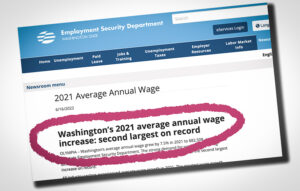 The costs of benefits available to injured workers under Washington’s workers’ compensation system, Washington’s unemployment insurance, and paid family and medical leave programs are adjusted annually based on changes to the average annual wage in Washington State. On Thursday, the Employment Security Department (ESD) released the wage calculation for 2021. According to ESD,
The costs of benefits available to injured workers under Washington’s workers’ compensation system, Washington’s unemployment insurance, and paid family and medical leave programs are adjusted annually based on changes to the average annual wage in Washington State. On Thursday, the Employment Security Department (ESD) released the wage calculation for 2021. According to ESD,
“Washington’s average annual wage grew by 7.5% in 2021 to $82,508. The strong demand for workers and hiring difficulties across different sectors drove average wage growth in 2021 to the second largest increase on record. “
The largest increase on record was in 2020 when wage growth exceeded 10%. ESD attributed the significant increase in 2020 to pandemic job losses among lower-paid workers. Because higher-paid workers kept their jobs, their higher wages brought up the average.
What does this mean for retail businesses?
Unemployment Insurance (UI) benefits paid to unemployed workers are adjusted annually based on changes to the average annual wage. For new UI claims filed on or after July 3, 2022, the minimum weekly benefit will increase from $295 to $317, and the maximum weekly benefit will increase from $929 to $999. These benefits are funded solely through employer taxes.
The taxable wage base in the UI program is also adjusted each year based on the annual average wage. The UI taxable wage base will increase from $62,500 to $67,600, meaning employers in Washington will pay UI taxes on the first $67,600 paid to an employee. Washington’s taxable wage base is consistently the highest in the country.
Paid Family and Medical Leave (PFML) benefits paid to employees are also adjusted annually based on the annual average wage. Premiums paid to fund the PFML program are shared between employers and employees. For paid family leave claims filed on or after Jan. 1, 2023, the maximum weekly benefit will increase from $1,375 to $1,427.
Workers’ Compensation benefits paid to injured workers may also increase; however, under Washington’s Workers’ Compensation premium allocation, most of the increases will be borne by workers.
In September, the Department of Labor and Industries will announce adjustments to the state minimum wage and workers’ compensation premiums. The annual changes to the minimum wage are based on the Consumer Price Index for Urban Areas; however, the annual average wage increase is often a strong indicator of what to expect with the minimum wage.





